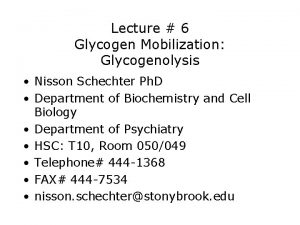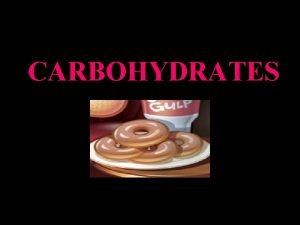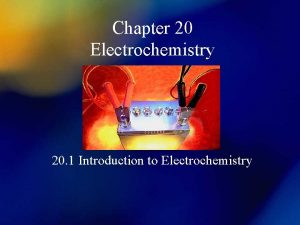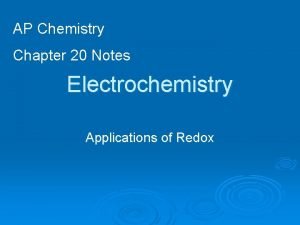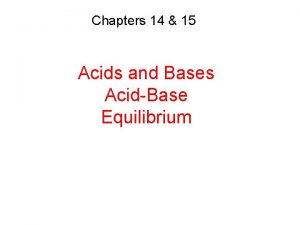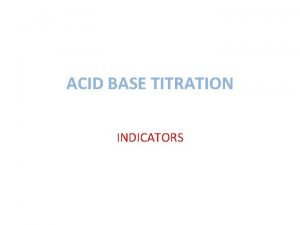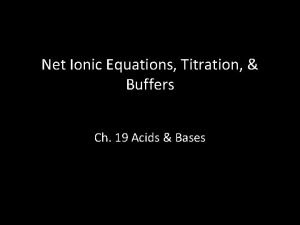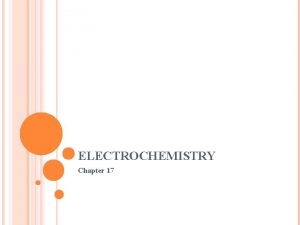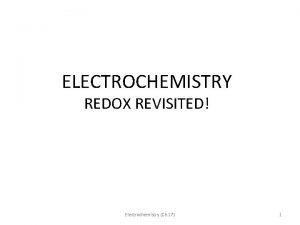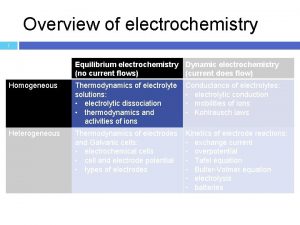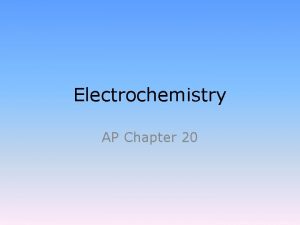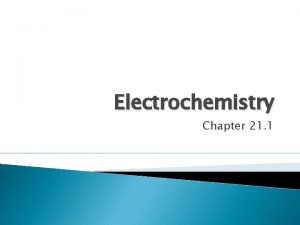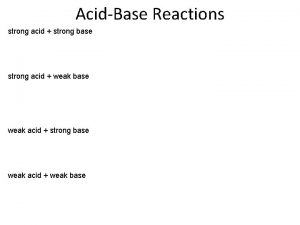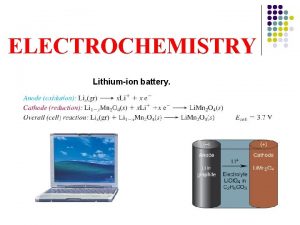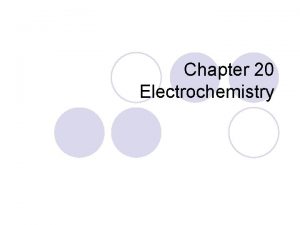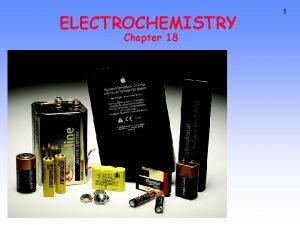Electrochemistry Review Which is a very strong reducing















- Slides: 15

Electrochemistry Review

Which is a very strong reducing agent? 1. 2. 3. 4. 5. 10 Mn. O 4 H+ H 2 Na Na+ 1 2 3 4 5 6 7 8 9 10 21 22 23 24 25 26 27 28 29 30 11 12 13 14 15 16 17 18 19 20

By definition, the reduction potential for this species is equal to zero. 1. 2. 3. 4. 5. 10 Mn. O 4 H+ H 2 Na Na+ 1 2 3 4 5 6 7 8 9 10 21 22 23 24 25 26 27 28 29 30 11 12 13 14 15 16 17 18 19 20

This is a very strong oxidizing agent. 1. 2. 3. 4. 5. 10 Mn. O 4 H+ H 2 Na Na+ 1 2 3 4 5 6 7 8 9 10 21 22 23 24 25 26 27 28 29 30 11 12 13 14 15 16 17 18 19 20

How many electrons are transferred in the following reaction: Mn. O 4 - + Cr + 2 H 2 O Mn. O 2 + Cr 3+ + 4 OH- 10 1. 2. 3. 4. 5. 1 2 3 4 0 1 2 3 4 5 6 7 8 9 10 21 22 23 24 25 26 27 28 29 30 11 12 13 14 15 16 17 18 19 20

In which of the following molecules does hydrogen have an oxidation state of -1? 1. 2. 3. 4. 5. H 2 O NH 3 Ca. H 2 CH 4 H 2 10 1 2 3 4 5 6 7 8 9 10 21 22 23 24 25 26 27 28 29 30 11 12 13 14 15 16 17 18 19 20

When solid copper shavings are placed in a solution of dilute HNO 3, Cu 2+ ions appear and NO gas bubbles form. Which of the following has occurred? 1. 2. 3. 4. 5. Cu has been oxidized by H+ Cu has been oxidized by NO 3 Cu has been reduced by NO 3 - has been oxidized by H+ NO 3 - has been reduced by H+ 1 2 3 4 5 6 7 8 9 10 21 22 23 24 25 26 27 28 29 30 11 12 13 14 15 16 17 18 10 19 20

The half reaction at the anode of a galvanic cell is as follows: Zn (s) Zn 2+ + 2 e. What is the maximum charge, in coulombs, that can be delivered by a cell with an anode composed of 6. 54 g of zinc? 1. 2. 3. 4. 5. 4820 coulombs 9650 coulombs 19300 coulombs 38600 coulombs 48200 coulombs 1 2 3 4 5 6 7 8 9 10 21 22 23 24 25 26 27 28 29 30 11 12 10 13 14 15 16 17 18 19 20

Ni(s) + Cu 2+ Ni 2+ + Cu(s) The reaction above takes place in a galvanic cell. If the initial concentration of Ni 2+ is increased while the initial concentration of Cu 2+ remains the same, what will be the effect on Q and E? 1. Q and E will increase 2. Q and E will decrease 3. Q will increase and E will decrease 4. Q will decrease and E will increase 5. Q and E will not change 1 2 3 4 5 6 7 8 9 10 21 22 23 24 25 26 27 28 29 30 11 12 13 14 15 16 10 17 18 19 20

Look up the reduction potentials for Cu 2+, Zn 2+, and Mn 2+. Which of the following reactions will occur spontaneously? 1. 2. 3. 4. 5. Mn 2+ + Cu Mn + Cu 2+ Mn 2+ + Zn Mn + Zn 2+ + Cu Zn + Cu 2+ Zn 2+ + Mn Zn + Mn 2+ Cu 2+ + Zn 2+ Cu + Zn 1 2 3 4 5 6 7 8 9 10 21 22 23 24 25 26 27 28 29 30 11 12 13 14 15 10 16 17 18 19 20

Which of the following statements is true for the following reaction taking place under standard conditions? Al(s) + Cr 3+ Al 3+ + Cr(s) 1. E = 2. 40 V, and the reaction is not spontaneous 2. E = 0. 92 V, and the reaction is spontaneous 3. E = -0. 92 V, and the reaction is not spontaneous 4. E = -0. 92 V, and the reaction is spontaneous 5. E = -2. 40 V, and the reaction is not spontaneous 1 2 3 4 5 6 7 8 9 10 21 22 23 24 25 26 27 28 29 30 11 12 13 14 15 16 17 18 10 19 20

What is the reaction potential for the following reaction? Fe 2+ + Cu Fe + Cu 2+ 1. 2. 3. 4. 5. -0. 7 V -0. 1 V 0. 7 V 1. 4 V 10 1 2 3 4 5 6 7 8 9 10 21 22 23 24 25 26 27 28 29 30 11 12 13 14 15 16 17 18 19 20

An electrochemical cell was created by placing a zinc electrode in a 1. 00 M solution of Zn. SO 4 and placing a copper electrode in a 1. 00 M solution of Cu. SO 4. The two compartments are connected by a salt bridge, and the following reaction occurred at 25 o. C. Zn(s) + Cu 2+ Zn 2+ + Cu(s) o o What is the standard potential for the cell? How much work can the cell do? What is the value of Keq for the reaction? At a certain point in the progress of the reaction, [Cu 2+] drops to 0. 10 M and [Zn 2+] increases to 1. 90 M. What is the cell potential at this point?

An 800 m. L sample of 0. 800 M Ag+ solution was electrolyzed, resulting in the formation of solid silver and oxygen gas. The solution was subjected to a current of 2. 00 A for 10. 0 minutes. The solution became progressively more acidic as the reaction progressed. o Write the two half-reactions that occur, stating which takes place at the anode and which the cathode. o If the oxygen gas produced in the electrolysis was collected at STP, what was its volume? o What was the mass of solid silver produced in the electrolysis? o If the solution was neutral at the start of the electrolysis, what was the p. H of the solution when the process was complete?

Sr(s) + Mg 2+ < -- > Sr 2+ + Mg(s) Consider the reaction above that occurs at 25 o. C. All reactants and products are in their standard states. The value of Keq for the reaction is 4. 2 x 1017 at 25 o C. o Predict the sign of the standard cell potential for a cell based on the reaction. Explain your prediction. o Identify the oxidizing agent for the spontaneous reaction. o If the reaction were carried out at 60 o. C instead of 25 o. C, how would the cell potential change? Justify your answer. o How would the cell potential change if the reaction were carried out at 25 o. C with a 1. 0 M solution of Mg(NO 3)2 and a 0. 10 M solution of Sr(NO 3)2 ? Explain. o When the cell described above reaches equilibrium, what is the cell potential?
 Ephesians 6:10-20 nkjv
Ephesians 6:10-20 nkjv Reducing sugar and non reducing sugar
Reducing sugar and non reducing sugar Glycogen metabolism
Glycogen metabolism Fehling's test for sucrose
Fehling's test for sucrose Reducing vs non reducing sugar
Reducing vs non reducing sugar Introduction to electrochemistry
Introduction to electrochemistry Chapter 20 review electrochemistry
Chapter 20 review electrochemistry Difference between a strong and weak acid
Difference between a strong and weak acid Mgkp
Mgkp How to remember strong acids and strong bases
How to remember strong acids and strong bases Acid base titration curves
Acid base titration curves Strong base strong acid
Strong base strong acid Ionic equation of titration
Ionic equation of titration Once upon a time there was a piece of wood
Once upon a time there was a piece of wood Andrex toilet tissue
Andrex toilet tissue Normal adjectives
Normal adjectives


